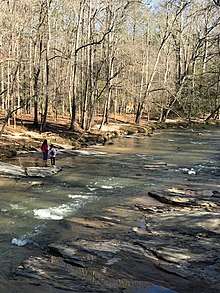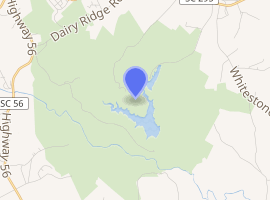Croft State Park
Croft State Park is a state park in Spartanburg, Spartanburg County, South Carolina, located on land used during World War II as a US Army basic training center and prisoner-of-war camp named Camp Croft.
| Croft State Park | |
|---|---|
 Fairforest Creek, Croft State Park, January 2020 | |

| |
| Nearest city | Spartanburg, SC |
| Coordinates | 34°52′31″N 81°50′28″W |
| Area | 7,054 acres (29 km2) |
| Open | 1949 |
| Camp sites | tent and RV sites |
| Website | https://southcarolinaparks.com/croft |
History
The land that is now Croft State Park was farmed from the late 18th century, and old farmsteads can still be found in the park as well as six family cemeteries and two church cemeteries.[1] During the American Revolutionary War, a skirmish between Patriots and Loyalists was fought at the juncture of Fairforest and Kelsey Creeks.[2] In the late 19th century a four-story hotel at Whitestone Springs attracted resort visitors to the supposedly healing lithium springs. The hotel burned in 1930, but the spring and some foundations remain and are accessible via a hiking trail.[3][4]
A year before the United States entered World War II, the federal government paid owners to appropriate their farm land and convert it into a basic training facility (Infantry Replacement Training Center) for the U.S. Army. Eventually a quarter million troops trained at the post, named for Major General Edward Croft (1874-1938), a native of Greenville, South Carolina, and a former chief of Army Infantry. Camp Croft boosted the local economy, especially during construction, though it also strained the housing, recreational, and health facilities of the small upstate community. During the last year and a half of the war, nearly a thousand German prisoners of war were interned there.[5][6]
Following deactivation of the base on July 31, 1945, the government sold 7,000 of its 19,000 acres to the state of South Carolina for use as a park, which opened in 1949.[7][8]
Activities and amenities
Park activities include picnicking, camping, hiking, geocaching, mountain biking, and bird watching. Fishing is available on two lakes, including the 165-acre Lake Craig.[9]
Amenities include a playground, picnic shelters, a shooting range, extensive mountain bike trails and a park store. Equestrian facilities include a stable with rental stalls, a show ring, and miles of horse trails.[10]
References
- "Findagrave". Findagrave. Retrieved January 2, 2020.
- "Spartanburg Revolutionary War Trail" (PDF). Spartanburg Revolutionary. Retrieved January 3, 2020.
- "Harris Lithia Springs". South Carolina Picture Project. Retrieved January 2, 2020.
- Henderson, Gary (December 4, 2004). "History Springs Forth in White Stone". goupstate.com. Retrieved January 2, 2020.
- "Camp Croft". South Carolina Encyclopedia. Retrieved January 2, 2020.
- Edward Croft was an 1896 graduate of the Citadel who served in World War I as a colonel and brigadier general; he was awarded the Purple Heart and Silver Star. On May 6, 1933, he was appointed a major general and chief of infantry. Upon retirement in 1937, he returned to Greenville. "World War II Camp Croft Photographs of Joseph Peter Pizzimenti". Spartanburg County Public Library. Retrieved January 3, 2020.
- "Camp Croft, South Carolina". SCHistory.net. Retrieved January 2, 2020.
- The park property has not yet been completely swept for possible unexploded munitions. Montgomery, Bob (October 30, 2018). "Millions still needed to rid Croft State Park of leftover munitions". GoUpstate.com. Retrieved January 2, 2020.
- "Lake Craig". gopaddlesc.com. Retrieved January 2, 2020.
- "Things to Do at Croft State Park". 2013-09-07.